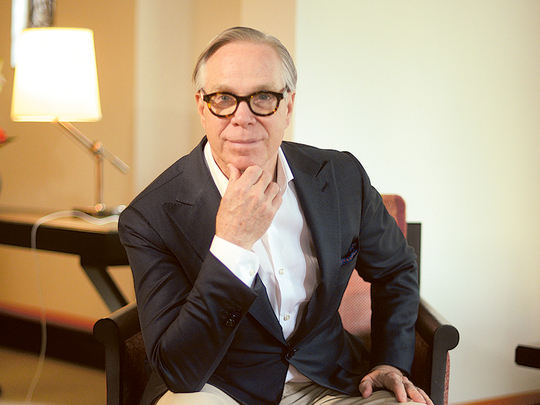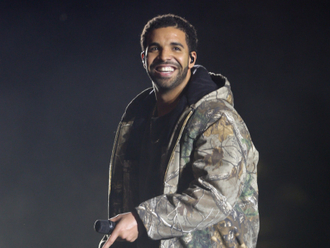
“Do you know what Fomo means?” Tommy Hilfiger asks with a glint in his eyes, immediately establishing his street cred with millennial acronyms. “That’s me. I’m Mr Fomo.
“I want to know what’s going on all the time… in the music world, in the skateboarding world, in surfing… in sports… everything,” he says. “I want to see what’s going on in real time. What are the it girls doing? What are they wearing and where are they going? What about the cool young guys? The athletes? The musicians?”
In the more than 30 years he’s been in the business that curiosity is how he’s stayed on top of things, he says.
Fomo, for those not down with the term, is Fear of Missing Out — the fear that you will miss out on something great.
The 65-year-old designer was in Dubai over the weekend where he was inducted into the World Retail Congress Hall of Fame. This year also marks 10 years since his brand came into the Gulf.
“I’m just having a look at all the store set-ups, having a feel for what we should be doing next, what we are lacking or what we can make adjustments on,” he says.
While the Middle East is not largely different from other markets, it’s changed a lot over the years, he adds.
“In the beginning when we came in [to the Middle East], we were very casual. Because that’s basically what we stand for. But in the last 10 years, we’ve added more formal menswear and womenswear. People are wearing formal with casual, they’re mixing it up.”
Hilfiger began working at the age of 18 when he opened his fashion retail and record store called People’s Place in 1968, combining his two great loves — fashion and music. The store expanded into a chain but went bankrupt in 1977, forcing him to find work as a freelance designer. It was while working for different brands in New York City that he met Indian businessman Mohan Murjani who was looking to start a fashion line. The two launched Tommy Hilfiger in 1985.
The brand’s fresh take on classic American staples, like sport jerseys, became a huge hit. And the high fashion for the masses marketing strategy worked like a charm. By 2000, Tommy Hilfiger was generating $2 billion (Dh7.3 billion) in sales a year.
In 2010, Hilfiger sold the brand to PVH Corp, which also owns Calvin Klein and Arrow, for a reported $3 billion. He remains the brand’s principal designer.
“For the day-to-day functioning, that’s handled by PVH. Our CEO Daniel Grieder, he’s amazing. My job is always looking at what we should be doing next,” he says. “Like this time last year, we were going to relaunch our underwear line and we were thinking about who [the face of the line] should be. Should we pick a Hollywood star? Or should it be musician?
“Then we thought of Rafael Nadal. He’s a friend, he’s a sports star, he’s got an incredible body and he’s very cool. So we asked him and he agree.”
It girl Gigi Hadid was picked to be the brand’s ambassador.
“She was walking our runway and was receiving more photographs worldwide and Instagram likes than anybody I have ever seen. She’s beautiful, she’s smart and she’s super nice. We’re also taking it a step further by doing a Gigi by Tommy Hilfiger collection and she’s actually designing with me,” he says.
Hadid’s collection is expected to be released by autumn this year.
“It’s a different world now,” Hilfiger says of the current generation of celebrities. “They are talking to the public in so many different ways, addressing millions of people every day. I mean, look at the Kardashians and the Jenners.”
That’s why it’s personally very important for him to be in touch with what’s going on.
“We’re all connected to FAME: fashion, art, music and entertainment — we’re all connected to pop culture. Which is what Andy Warhol brought us, and he inspired me.”
The next threshold for his brand, he says, is digital.
“Everything is going to be tech-oriented. Whether it’s wearable tech or something to do with phones, we’re all going to be multimedia and omni-channel. Shopping isn’t just one way any longer.
“And the consumer is the boss. He or she will see runway shows and want the clothes that day. They don’t want to wait six to eight months for the clothes to be shipped to the stores. Years ago, we were opening our shows to press, buyers and a few celebrities. Now we’re going to open it up to the public. Because the public want to look at the show, and click and buy.”
The current trend of designers leaving fashion houses could end up affecting the brand, he says. Earlier this month, Saint Laurent designer Hedi Slimane became the fourth major creative director to leave a high-fashion brand since Alexander Wang left Balenciaga last July. Raf Simons stepped down from Christian Dior in October and Alber Elbaz, the long-time designer at Lanvin, also left in October.
“If I were the owner of Saint Laurent, I would not be happy with Hedi leaving because he really changed the business for Saint Laurent,” says Hilfiger. “I don’t know if it’s going to affect the consumer, because they have so many choices anyway. Whoever comes in will probably do an OK job and the clothes will still sell, the accessories will still sell. Maybe not to the extent that they were selling in the last four years, but if they don’t buy from Saint Laurent, they will buy it from Gucci or Dolce & Gabbana.”
If he were ever to pass on the baton to another designer, it would have to be one willing to do what he set out to do, he says. “We have a certain signature and a certain look. I wouldn’t want to dramatically change it but I would want to evolve it. So many people say we’re preppy. But preppy can be rock ‘n’ roll, it can be biker, preppy can be sporty or outdoorsy… or chic. It can be a lot of things. I want someone who understands that language and moves the brand forward.”
He’s not going anywhere, for now.
“I have some life left,” he says, laughing. “I look at Giorgio Armani, Karl Lagerfeld, Ralph Lauren… these guys are in their 80s. I am only in my 60s. I’ve got at least 20 years or more. It’s amazing what I do. I love it and I don’t want to ever stop.”
Tommy Hilfiger on…
Internet rumours
“I’ve been a victim,” Hilfiger tells Gulf News tabloid!. In 1996, a nasty email began to circulate claiming Hilfiger had been kicked out of the Oprah Winfrey Show because he said he was disappointed black people and Asians were wearing his clothes. The designer eventually got on Winfrey’s show for the first time in 2007 to set the record straight. Winfrey called the rumour a “Big, fat lie.” While the rumour never hurt his business, Hilfiger had said it hurt him personally, “because it couldn’t have been further away from the truth”.
Mentoring
“I’ve always loved giving back,” says the designer who’s mentored now well-known names such as Prabal Gurung, Peter Som and Simon Spurr. “People helped me out along the way and it’s my pleasure to help them. And they are all so talented.”
Things he will never do as a designer
“I would never do couture, because that’s an art unto itself. I would never try to do it. And the sneakers with all the gold chains and studs, I would never do. I don’t like bling. I like fun,” he says, laughing.
What he’s listening to
“Ever since David Bowie died, I’ve been listening to a lot of his music. I loved his music. David and I were friends. So I really miss him. I also listen to the Rolling Stones. And I listen to The Weeknd and Katy Perry. I listen to some Kanye, Jay Z and Beyonce and Travis.”











